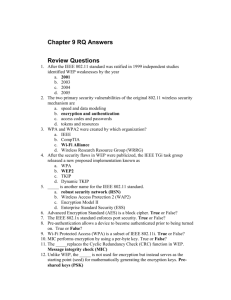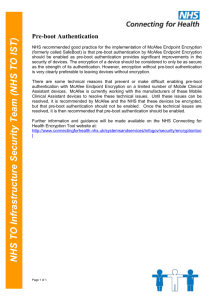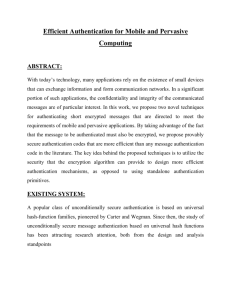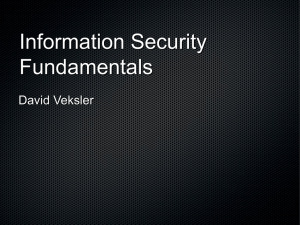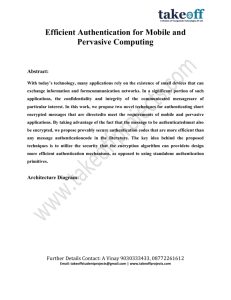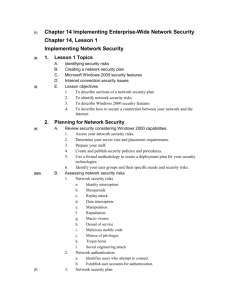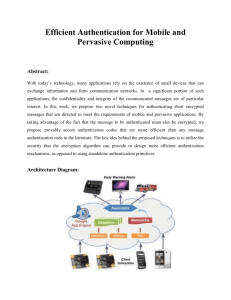WLAN Information Security
advertisement
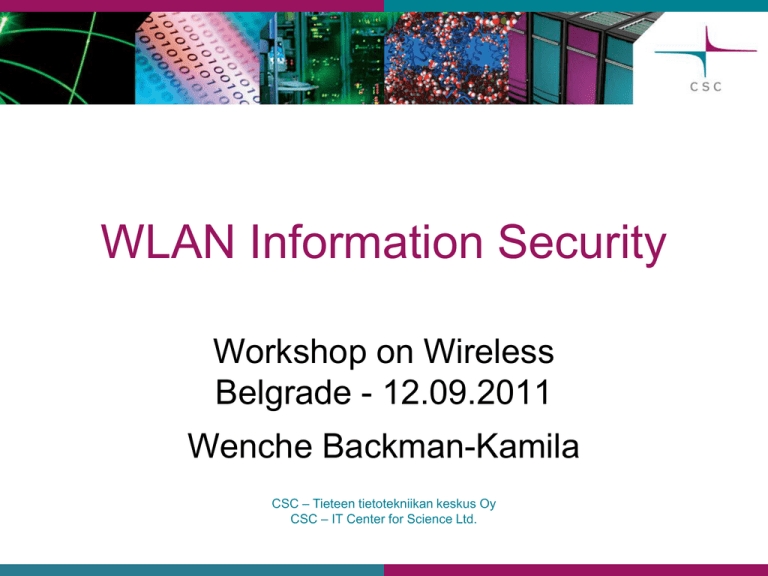
WLAN Information Security Workshop on Wireless Belgrade - 12.09.2011 Wenche Backman-Kamila CSC – Tieteen tietotekniikan keskus Oy CSC – IT Center for Science Ltd. Let’s clean up the mess! WPA2 webauthentication Agenda • The physical interface • Authentication • Encryption • Traffic management • Recommendations and comments The physical interface • Licence-free frequency bands – 2,4 – 2,5 GHz (802.11b/g/n) – 5,2 – 5,7 GHz (802.11a/n) • Threaths – Interference from • Microwave owens and motion sensors • Bluetooth, other wireless equipment, other WLANs • RF jammers – DoS attacks (assosiation or EAPOL Start) AUTHENTICATION Overall security of authentication methods 802.1x networks alternatives • 802.1x networks = eduroam networks • 802.1x based on EAP • EAP alternatives – TLS • Requires personal certificates but no username and password – TTLS, PEAP and FAST • Authentication based on username and password Supplicant configuration considerations • For 802.1x to be really secure pay attention to which server certificate is used • In the supplicant – Define correct CA – Define server name • More info in WLAN monitoring and supplicants - session Information security risks in web-authentication • The authenticity of the login page cannot be verified • User IDs and passwords can be intercepted and sessions hijacked. Authentication considerations • Content of database – Eliminate authentication with shared user identities • Impact of compromised credentials ENCRYPTION Wireless security vs wired security • Signals from Access Points can be captured at the air interface • Information security risks – Sniffing – Spoofing – Probing More security risks – and countermeasures • Firesheep – Users may get their profiles to e.g. Facebook hijacked • Countermeasures – VPN encryption • High requirements on the VPN server • Performance usually drops – ->Link-layer encryption Overview of encryption development Personal and Enterprise • WPA-Personal WPA2-Personal (=WPAPSK WPA2-PSK) • WPA-Enterprise WPA2-Enterprise (=802.1x) Details on WPA-TKIP and WPA2-AES WPA-TKIP • regular key rotation • per-frame key mixing • a frame sequence counter to protect against replay attacks • an improved message integrity check algorithm. WPA2-AES • Actually AES-CCMP at link layer • A single component handles – per-frame key management – integrity checks TKIP-vulnerability • End of 2008 – Injecting false messages of a few types (e.g. ARP) possible • September 2009 – Forging short encypted packes (e.g. ARP messages) in shorter time (1 min vs 12 min) – Increased likelihood of session being hijacked • Although encryption key never exposed – -> use only WPA2-AES Wi-Fi alliance and WPATKIP • Wi-Fi alliance will abandon WPA-TKIP in stages 2011-2014. Encryption conclusions • Always use the most secure encryption method WPA2-AES • Why? – When all use the same method roaming becomes easier – The Wi-Fi alliance is discontinuing support of WPA-TKIP • For access to intranets etc. include also VPN encryption TRAFFIC MANAGEMENT Authorisation • Minimum requirement is Internet access • Separate VLAN for own users and visitors – @myorganisation more rights and privilegies • Check visitor VLAN carefully – no protected networks or machines using the same VLAN • If possible access to printers and journals for all MAC address blacklisting • Information security and stability can be improved – by stopping • Too frequent authentication requests • Spreading a worm • constantly receiving new IP-addresses – by handling notifications of copyright violations • The user should be notified of blacklisting Other restrictions • SMTP – Only access to own servers allowed – Block connections from the Internet • Block devices from acting as DHCP servers • Make terminals communicate with each other through the AP RECOMMENDATIONS Regarding authentication • Inform of the weaknesses of unencrypted networks – and of the need to switch to 802.1x • Consider implications of stolen passwords • Or use different passwords for WLAN • Grant access to VPN without webauthentication • Don’t allow use of unencrypted protocols in unencrypted networks Comments regarding authentication • Open networks are misused and copywright infringements occur • MAC address blacklisting improves security and stability Regarding encryption • Use only WPA2-AES – If you have VERY good reasons allow also WPA-TKIP – Acknowledge supplicant configuration implications • Unencrypted networks are risky – Open networks – Pre-shared key networks – Web-authenticated networks References and contact info • Main reference – WLAN Information Security BPD • http://www.terena.org/campus-bp/bpd.html • Wenche.Backman-Kamila@csc.fi



